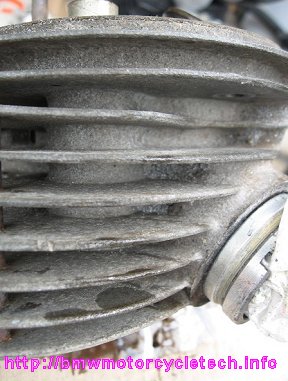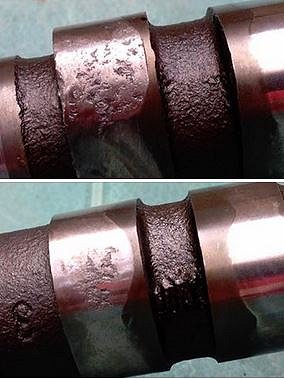seal..etc., it is CRITICAL that the crankshaft be BLOCKED from moving forward. If you do NOT block the crankshaft, you run the risk of the crankshaft moving forward a small amount. This can result in a HIDDEN thrust washer moving downwards and off its two locating pegs. If that happens, the washer will not align back on those two pegs as you tighten the 5 flywheel (or clutch carrier) bolts, and you run the risk of MAJOR DAMAGE to the thrust washer….and even MAJOR damage to the engine casting. The crankshaft will begin to freeze up as you tighten those 5 bolts. There is another similar thrust washer located rearward of the engine casting, and it can also come off its pegs. I install it oiled, which acts like mild glue when installing the flywheel (clutch carrier) You REALLY do NOT want any of these problems happening. If you forgot or did not know about blocking the crankshaft, and you want to know IF the crankshaft has moved, there is a link near the end of this article, which will give you the information. The dimensions need to be as shown, in order to know that the crankshaft has not moved. The only way to see and get the hidden thrust washer back in place, if it has moved off the pegs,
Category: Technical Tips
Fuel system. Tank cleaning & protection. Premium vs. Regular. Fuel additives. Fitting other tanks/seats. Rusted/frozen seat hinge screws. Throttle & choke cables. Fuel hoses. Tank sealants/liners.
Tank cleaning & protection methods. Premium vs. regular. Fuel additives.
Fitting other tanks…seats & fitment with various tanks. Pesky
rusted/frozen screws on seat hinges. Throttle & choke cables.
FUEL HOSES. Tank sealants & liners.
No Spark on a /7
I have a ’78 R100/7. It’s my first BMW. It broke down a few weeks ago and I never got it started again. The problem is I have no spark. The local shop is no help unless you bring the bike in and I don’t trust them. I don’t think it would be a coil because there’s no spark on either side.
Double Row Timing Chains for Dummies
YOU CAN DO IT. You will want to replace everything. Don’t do a rinky dink job that will need to be redone sooner rather than later. Replace the chain $35, crankshaft nose bearing $10 and sprocket $65. Also replace the tensioner $10 and spring $2, and all gaskets and seals $17. These are 2003 prices. I got everything from Motobins and Eurotech. I found that the most worn piece was the crankshaft sprocket. The chain and bearing actually do not wear that much, but that sprocket is half the size of the cam sprocket and made of some soft stuff. The teeth get narrow and pointy. The gap between the teeth gets really wide as the sprocket wears. That’s where most of the slop in the old chain comes from.
Cylinders, case stud threads, heads, top-end, intake spigots, break-in procedures
If you are installing a camshaft and/or followers, READ http://bmwmotorcycletech.info/cams.htm regarding assembly pre-lubrication.
You may think that pulling off a jug is major surgery & frightening to contemplate. Once you do it, perhaps at a TechDay; or, from the information in this article, you should no longer have much apprehension about doing it yourself.
CAUTION-1: Every year comes questions about removing a head, perhaps for a simple de-coking (and not pushrod tube seals), & whether it is possible or not….to keep the cylinder sealed at the bottom. In order to do this, you would have to very securely wrap bungees …or via some other means, …around the cylinder fins, across the motor, & all-around the motor. Or some such. You would have to keep the cylinders from moving off the base area in the slightest. This method has been done when I only needed to work on the heads & was being done ‘in the field’, such as at a Rally, or a TechDay, & no O-rings and no piston ring compressor were on hand, etc. But, in order to do it, the bungees must be super-tight & evenly surrounding the cylinder, fore & aft. I recommend you not try it. Chances are high that you will not be fully successful & your cylinders will leak oil.
CAUTION-2: Never reuse a head gasket unless it is a real emergency. While it is possible to leave the two head-to-barrel nuts in place (the ones located at 12:00 and 6:00), & to reuse the gasket by never separating the head from the barrel, this is a poor idea. It MIGHT result in distortion of the assembly. I have not seen that distortion, if the assembly is done fairly quickly, within minutes. Pure speculation anyway. These 2 head nuts (located at 12:00 & 6:00) are supposed to be the first to be loosened, the last to be tightened (in the usual cross-staging).
Cylinders (iron, steel, Nikasil, Galnikal). Boring, honing, cylinder shims, plates, gaskets, o-rings.
BMW has used both Galnikal & Nikasil in describing their late cylinders, & never explained the difference. BMW used at least two companies in producing these cylinders for them. They are basically the same process. Nikasil is a registered trademark of Mahle Gesellshaft (yes, the piston and filter makers). Coated cylinders are done via a plasma process, in Stuttgart, & is a blend of nickel & silicon carbide. Galnikal is a trademarked name for the process used by Kolben Schmidt, which is a major German foundry & castings maker. They also make pistons. If you have Kolben Schmidt cylinders, or other products, they use a symbol which is a letter “K” on top of a letter “S”, and it looks like this:
Changing a Timing Chain
Getting started: I, having done this a number of times, budget about three to four hours to do this task. I’ve done it in two hours with everything going well. Sometimes you find the exhaust nuts are frozen on. Sometimes the universe is just not going to let you get that keeper/clip on the timing chain until you have REALLY demonstrated you want it. And so on. First time? Four hours: minimum. I would place this in the “advanced intermediate” catagory of dificulty.
Change oil if it is nearing that time. Turn engine to Top-Dead-Center. You have to clear away obstructing parts first: namely the front wheel, fender and exhasut system. Drop the exhaust pipes and headers, pull the front wheel and remove the fender/lower sliders, after draining fork oil (now might be a great time to do fork seals too…). It helps to have the bike on the center stand and a couple of 2X4s to get the front end up. Now remove the tank, disconnect the battery ground cable, loosen the carbs and remove the air cleaner assembly. Remove the starter motor cover, this is the cast aluminium piece on top of the engine block, you may have to undo the coils and move them out of the way to accomplish this.
Camshafts, broken cam tips, cam sprockets, lifters (followers), alternator & cam seals, crank nose bearing, etc. Sports-cams installations. Assembly lubricants.
STOCK, original equipment camshafts:
For the stock cams, at .0787″ valve lift (2 mm), the timings are as follows, keep in mind that two types of these cams installation available, the 3° advanced one & the not advanced one.
R50/5, R60/5, and R60/6 to 1975:
BMW issued a SI on that camshaft, saying that some published information was NOT correct. BMW said the correct figures are:
Intake Opens TDC; Intake Closes 40° ABDC; Exhaust Opens 40° BBDC; Ex Closes was illegible, but I am sure it said 40° BTDC. If you were to look up the sprocket and camshaft in the present parts fiche, it would be 11-31-1-250-253, sprocket.
284° camshaft, used UP TO 09/1975, 11-31-1-259-262.
UNfortunately, BMW is confusing itself. You will find that other manuals say Intake Opens 40°ATDC….all the numbers are 40°; that includes the intake opening at 40° ATDC.
Engine, frame, and other numbers/characters. How to read and interpret them. How does BMW identify the year of your motorcycle, etc. Serial numbers. VIN (Vehicle Identification ‘Numbers’) & other identifications. How to identify your motorcycle and major assemblies.
This article contains a large amount of information regarding vehicle numbers and identifications, most especially for BMW Airhead motorcycles, but much of this information also applies to other motorcycles, and even your automobile, truck, etc. Information may seem confusing at first. You are advised to slowly read this entire article, and then re-read; and then look at the numbers on your own bike(s), car, truck, etc.
You may be interested in the information in: https://bmwmotorcycletech.info/models.htm and https://bmwmotorcycletech.info/transmission.htm. Those two articles have some further identification information.
There is a LOT of wordy reading here …but, it can be important!
NON-USA-SHIPPED-BIKES:
BMW may use different frame and motorcycle identification systems for non-U.S.A. motorcycles. There may be a letter or two letters, followed by a serial number. There may be a serial number followed by one extra number, and then the type of motorcycle. Seven (7) digits are used for the serial number. I do not know what the letters nor the 8th digit means, it could be a check-digit. The VIN system of 17 characters may be absent, in favor of just the Serial Number, with possibly a very small BMW roundel stamping and a letter or two or other number or two. This has especially been seen in later Airheads for ECE shipments. In general, the 17 character VIN system was introduced in approximately 1980-1981.
Serial/frame identification numbers, year, code, power output, from the earliest BMW motorcycles to mid-1990’s
NOTES:
(1) This article’s information was gathered from quite a number of sources, places and publications; but especially from several old factory (German literature) publications. It is believed mostly, but not absolutely correct. BMW factory literature varies in production numbers and serial numbers for quite a few models. BMW has, at times, confused…and mixed-up…their own figures. This has been particularly so when BMW has used both reserved serial numbers range for a model; and, serial numbers for actual production. BMW vehicle numbers are the serialized number of the frame or engine or both, the more modern versions of which can be 6 or 7 digits, and can be seen on the engine, and/or frame. After ~1980, the numbers are usually the last 7 digits in the new 17 character VIN numbering system, but this is not universal for all Country’s shipped-to. From 1984, BMW stopped stamping serial numbers into the area next to the engine oil dipstick. There is a LOT more to all this. See (5) below; and, see my companion article: https://bmwmotorcycletech.info/IDnumbrs.htm.




